The Florence Cathedral, Santa Maria del Fiore, also known as the Florence Duomo, is one of my favorite buildings in the world. It’s where I spent my college internship giving free tours to visitors. I spent hours explaining the art, architecture, and historic significance of the building.
The Florence Cathedral is also one of the most popular attractions in the city. The other most popular attractions are the Uffizi Gallery and the Palazzo Vecchio.
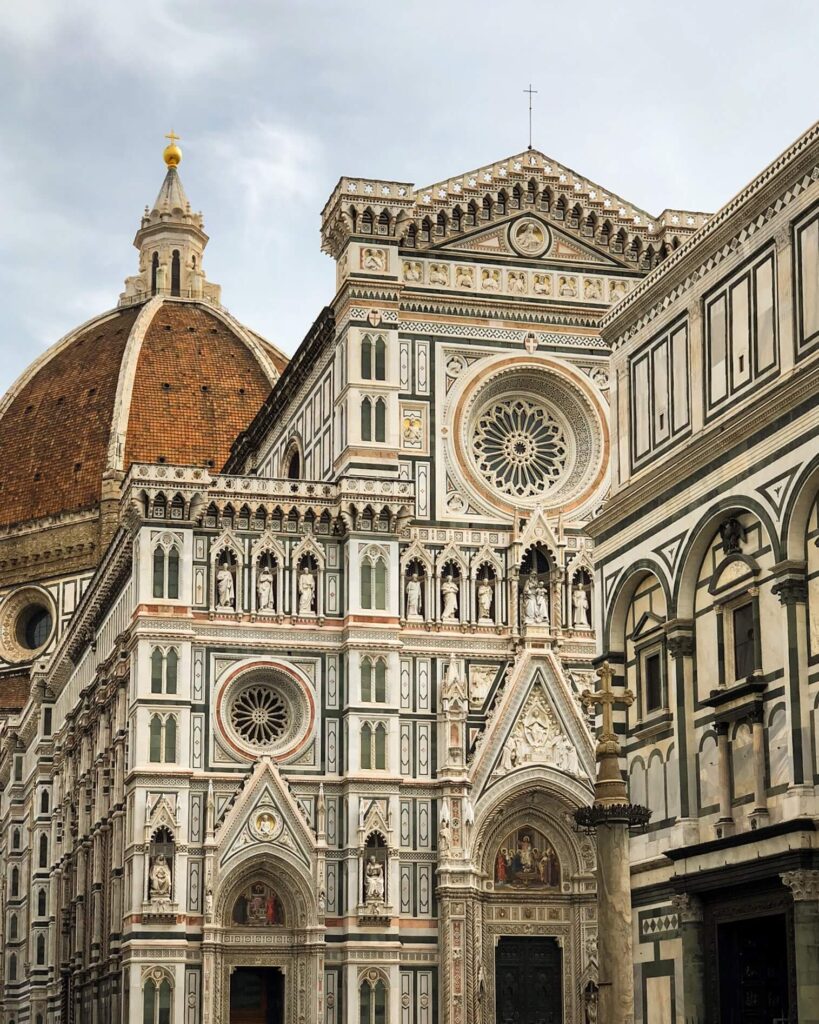
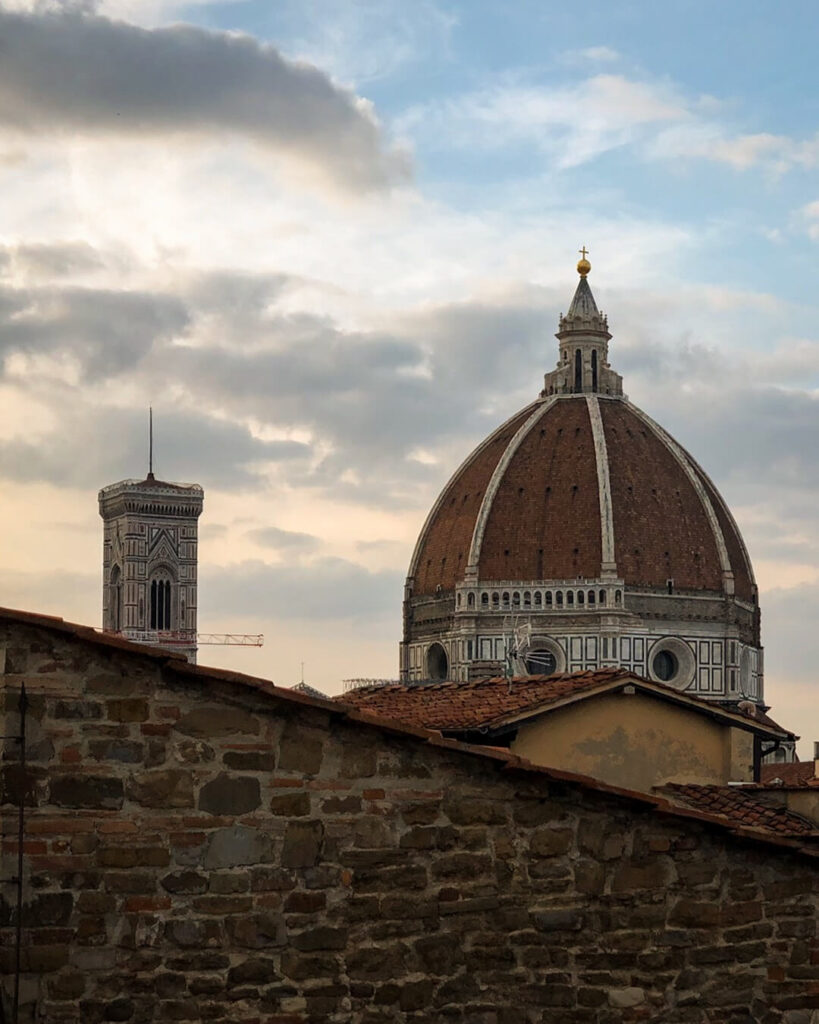
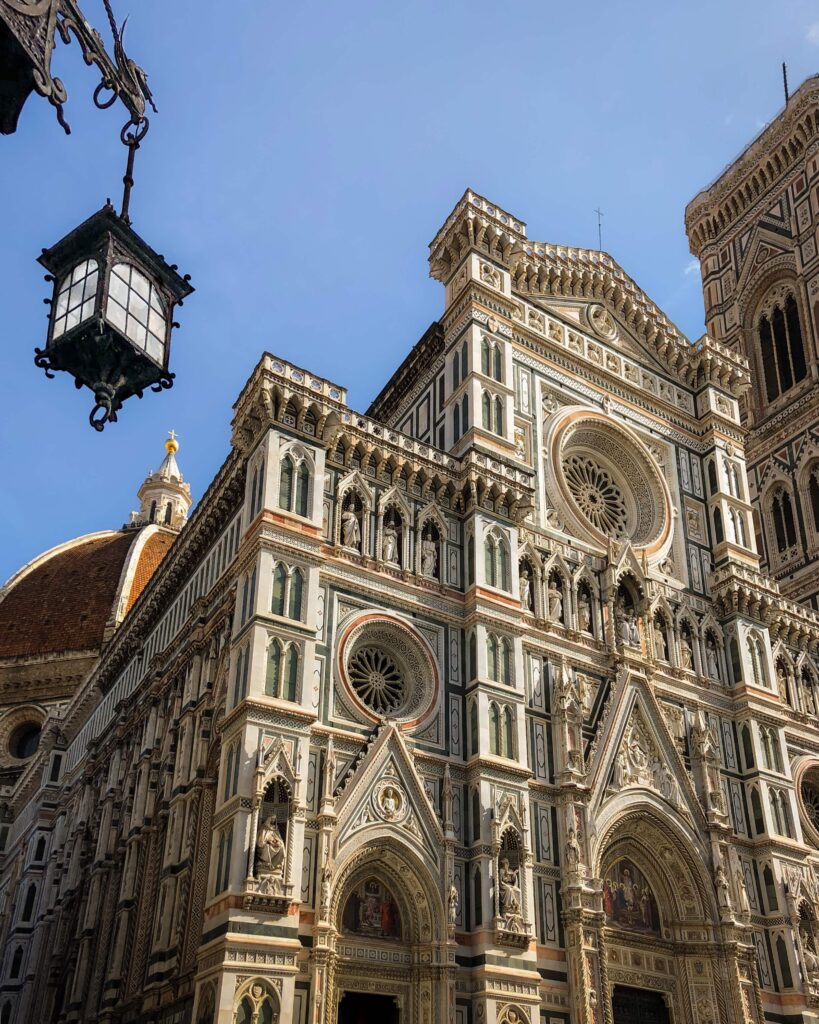
The cathedral’s dome dominates the city’s skyline. It’s a monument to Renaissance ingenuity and the crowning achievement of its architect, Filippo Brunelleschi.
It’s hard to imagine the skyline of Florence without Brunelleschi’s dome. It has a timeless feel, like it’s always been there.
Together with the Campanile di Giotto (Giotto’s campanile, or Giottos bell tower), the Florence Baptistry (Battistero di San Giovanni, or Baptistry of St. John), and Il Duomo, the buildings form the centerpieces of the Duomo complex, Piazza del Duomo, and the heart of the city of Florence.
But there are probably a few things you didn’t know about the Florence cathedral and dome.
Discover More: Florence Neighborhoods to Explore on Your Next Visit
When the Florence Duomo was started in 1296 no one knew how to build the dome
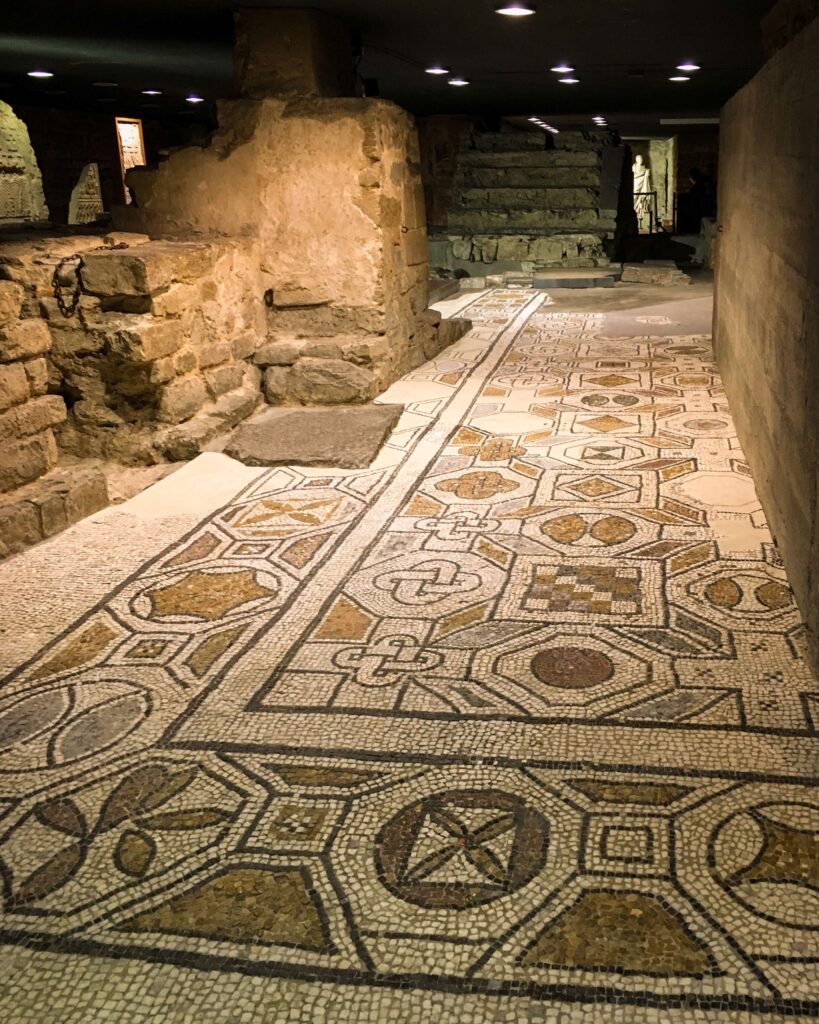
The Florence cathedral was built over the site of an older church, Santa Reparata. What is left of Santa Reparata can still be seen in the cathedral crypt.
The first stone for the new Florence Cathedral, Santa Maria del Fiore, was laid in September of 1296. It was intended to be a gothic church, with a design by Arnolfo di Cambio.
While the design was impressive, for years after the cathedral was started it remained roofless and open to the elements.
Why?
Because no one knew how to build a dome as big as the one planned for Santa Maria del Fiore.
The architects had designed a plan for a 45.5 meter (150 foot) wide dome to rise from the center of the magnificent building. However, the largest dome built to date was the Pantheon in Rome, measuring 43.4 meters (about 142 feet) and no one knew exactly how it had been constructed.
So what did the architects do?
They started building anyway, having faith that eventually someone would come along who knew how to build what they envisioned.
It took over 100 years after the cathedral was started, but they were right.
On August 19, 1418 a competition was declared, calling for anyone who could make a model or design for the dome itself or any piece of machinery that could help build it to submit their plans. The reward would be 200 gold Florins, more than a skilled craftsman could earn in two years of work.
Competitions like this were common during the Italian Renaissance of the 15th century, sort of a way to put work out for bid, and anyone could submit a model or idea for consideration.
One of the models was submitted by Filippo Brunelleschi, a 41 year old goldsmith and clockmaker. In the end it was his model that was accepted, and Brunelleschi began his life’s work of completing the dome.
It has the largest masonry dome in the world
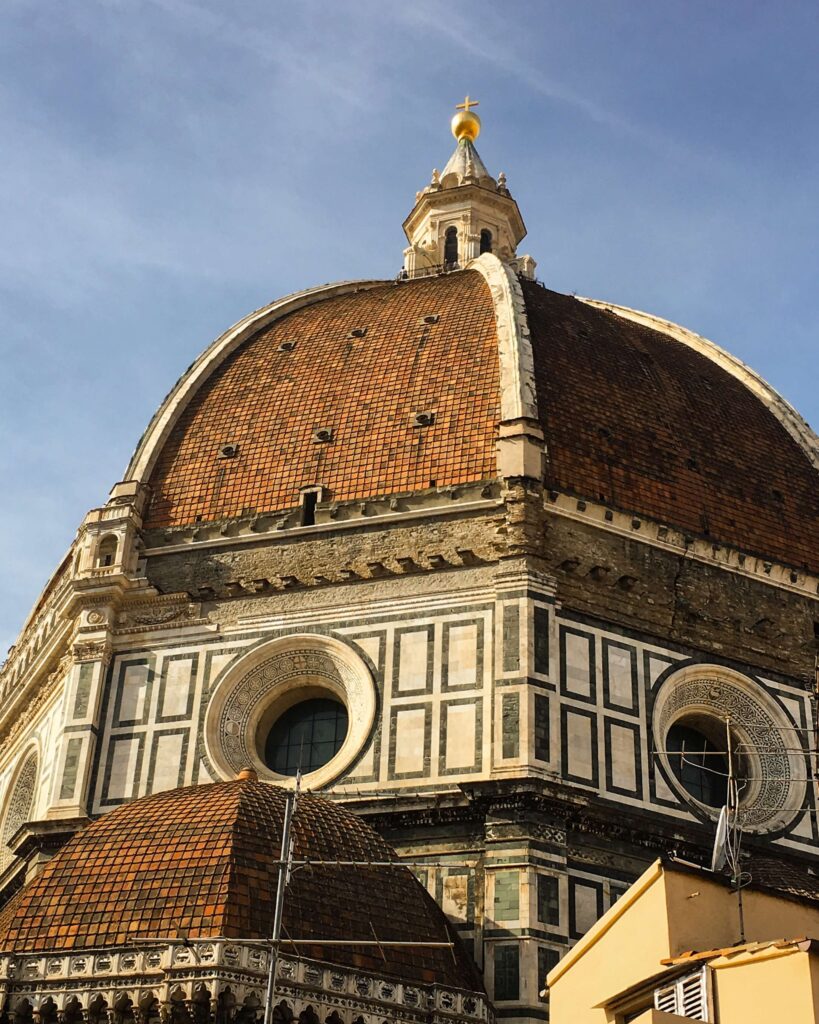
To this day Brunelleschi’s dome is the largest masonry dome ever constructed.
It’s an ingenious structure, difficult to construct even with today’s advanced technologies. Engineers are still studying it and discovering the secrets of its construction.
In Brunelleschi’s day it would have been nearly impossible to build, and since he didn’t keep many records we still don’t know exactly how he did it.
What we do know is that failure was a definite option. Several domes and arches constructed prior to Santa Maria del Fiore failed. These included the Cathedral of Saint-Pierre at Beauvais in France which collapsed in 1284, only a decade after completion and less than 10 years before Santa Maria del Fiore was started.
Filippo Brunelleschi had no architectural training
A goldsmith by trade, Brunelleschi was ahead of his time in many ways. Not only did he design and oversee the construction of the cathedral dome, he also developed the science behind linear perspective and the vanishing point as we understand it in art today.
Brunelleschi had long been interested in solving mechanical problems, so at the age of 15 he was apprenticed to a goldsmith. Goldsmiths at that time were expected to possess varied talents, which made it a good fit for a boy of Brunelleschi’s mechanical bent.
He would have learned to set precious stones, cast metal, work with enamels, engrave silver, decorate with gold leaf, and other skills. Many well-known artists and sculptors previously trained as goldsmiths, including Leonardo da Vinci and Donatello.
Along with his training as a goldsmith, Brunelleschi also studied clock making, giving him extensive knowledge of weights, wheels and gears. This knowledge was key in building the dome, as he was required to build ingenious cranes and pulley systems to both lift and place the huge stone blocks and loads of bricks required during construction.
The dome wasn’t the only competition related to Il Duomo di Firenze that Brunelleschi entered.
In 1329, Andrea Pisano had crafted a beautiful set of doors for the east side of the Florence Baptistery (these doors now sit on the south side).
When it was time to create doors for the other sides of the Baptistry of St John, of course a competition was held. Brunelleschi entered this competition, along with Lorenzo Ghiberti and many other artists. Ultimately Ghiberti and Brunelleschi were both declared the winners and commissioned to work on the doors together, but this was a blow to Brunelleschi’s pride and he left for Rome.
Ghiberti went on to complete not only that set of doors, but also the most famous set known as the “Gates of Paradise”. These doors now stand in the Museo dellOpera del Duomo (Duomo Museum) to protect them from the elements, the doors on the baptistry are reproductions.
The Florence Cathedral dome was completed in only 16 years
Which is quite amazing considering the entire cathedral took over 140 years to build!
The competition for the building of the dome wasn’t held until 122 years after the first stone was laid in 1296. By the time Brunelleschi was born it had already been under construction for 80 years.
Given the radically new construction techniques, the machines that had to be designed and built just to lift the bricks and stones to the construction site, and the technical difficulties that had to be overcome, 16 years was an astoundingly short length of time to complete Brunelleschis dome.
There are 463 steps to the top
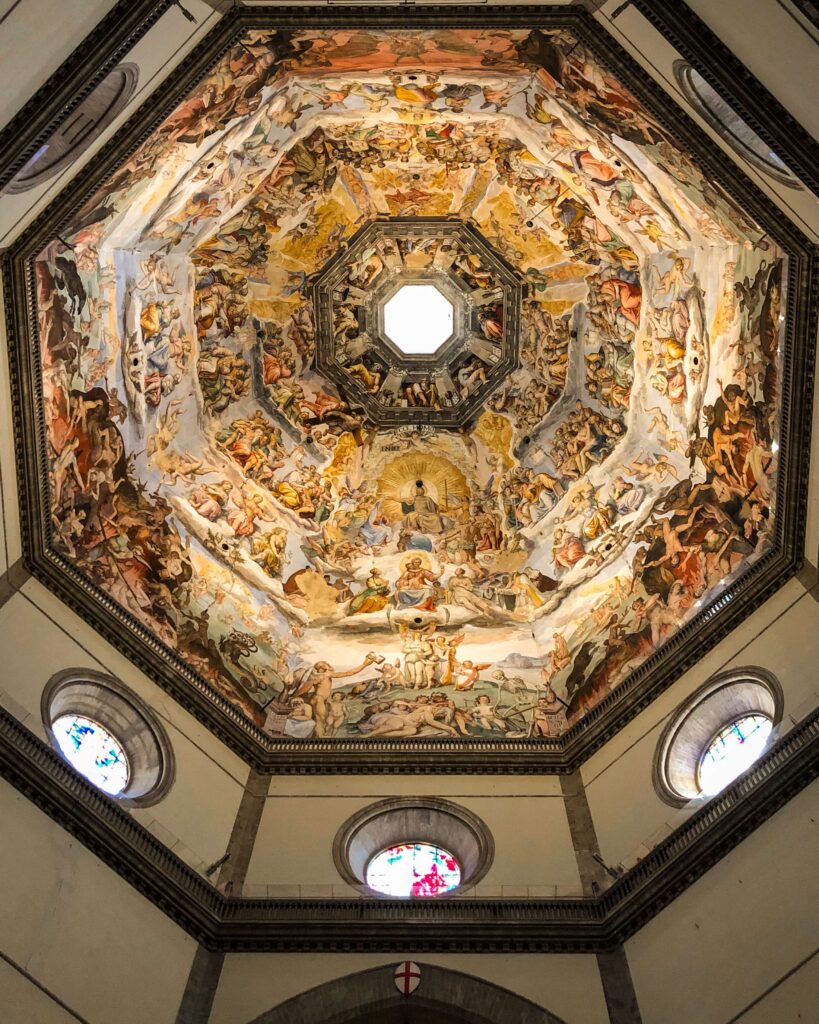
The dome of the Florence Cathedral wasn’t meant to be climbed by the public. The stairs were intended for construction and maintenance of the dome.
However, if you’re up to the climb it’s well worth the trek. It is the only way to see the interior frescos up close. You’ll also walk in the space between the inner and outer domes. Here you can see the ingenious construction methods for yourself.
You’ll see the frescoes, painted by Giorgio Vasari and Federico Zuccari, as you come out onto the walkways inside the cathedral just under the dome, close to the midpoint of the climb. If you’re afraid of heights this is not a climb for you! I didn’t realize I have, as my dad puts it, “a healthy respect for heights” until I climbed the dome for the first time a few years ago.
Stepping out onto the ledge inside the cathedral was… an experience.
Actually, it was quite terrifying. I almost had to turn around and go back, but decided I was determined to make it to the top.
Of course, the whole way up and down I was acutely aware of exactly what was below me. The interior dome, and a whole lot of nothing.
Would I do it again? Yes.
There’s no other way to see the detail of how the dome was built, and the view from the top is the most impressive in Florence. From up there you can see all the sights of Florence just by walking the circle of the lantern (the name for the structure on top of the dome).
If you make the climb, see if you can pick out the Pitti Palace, Boboli Gardens, and Piazzale Michelangelo across the Arno, the Palazzo Vecchio and Ponte Vecchio, and the churches of Santa Maria Novella, Santa Croce and San Lorenzo. On a clear day you can see up to Fiesole in the hills above the city.
Builders constructed the dome without using any centering
Builders use the term centering for wooden scaffolding or structures that support an arch or dome during construction. It was (and still is) a normal practice to build centering, then construct a dome.
But that would be a problem for the Florence Cathedral. It was so large and high off the floor that builders wouldn’t find enough trees in all of Tuscany to build centering.
There was discussion of using dirt instead, which had been done for other domes, but how would they excavate the space once the dome was built? One idea was to bury gold Florins in the dirt. When construction was complete, people could dig for the coins and excavate the building. This idea was quickly dismissed.
Every design submitted for the dome other than Brunelleschi’s required centering. But Brunelleschi’s design and model was radically different. When asked how he would complete the dome without support he wouldn’t say. He refused to give away technical details of his plans to ensure no one else could steal his ideas.
People branded Brunelleschi a madman, “an ass and a babbler.” Officials physically removed him from one meeting with the council while choosing the competition’s winner.
The council eventually adopted Brunelleschi’s design, but added one important condition. Builders would construct only the first 30 braccia (about 55 feet, or a quarter of the height) without centering. After that, the council would build it “according to what shall then be deemed advisable,” allowing for possible use of centering later.
In time, Brunelleschi proved his plans workable, and builders completed the rest of the Florence Cathedral dome without scaffolding or centering.
Only one side of the drum was completed
The drum is the octagonal section just below the dome that the dome rests on.
If you look at it from the outside you’ll notice something. One of the eight sides has a “balcony”, and seven sides are plain sandstone.
This drum decoration was designed by Baccio d’Agnolo. He started the project in 1506, but the design was criticized by Michelangelo as looking like a “cricket’s cage.”
At that point D’Agnolo stopped work on the drum and the work was never finished.
The facade of the Florence Cathedral wasn’t completed until 1903
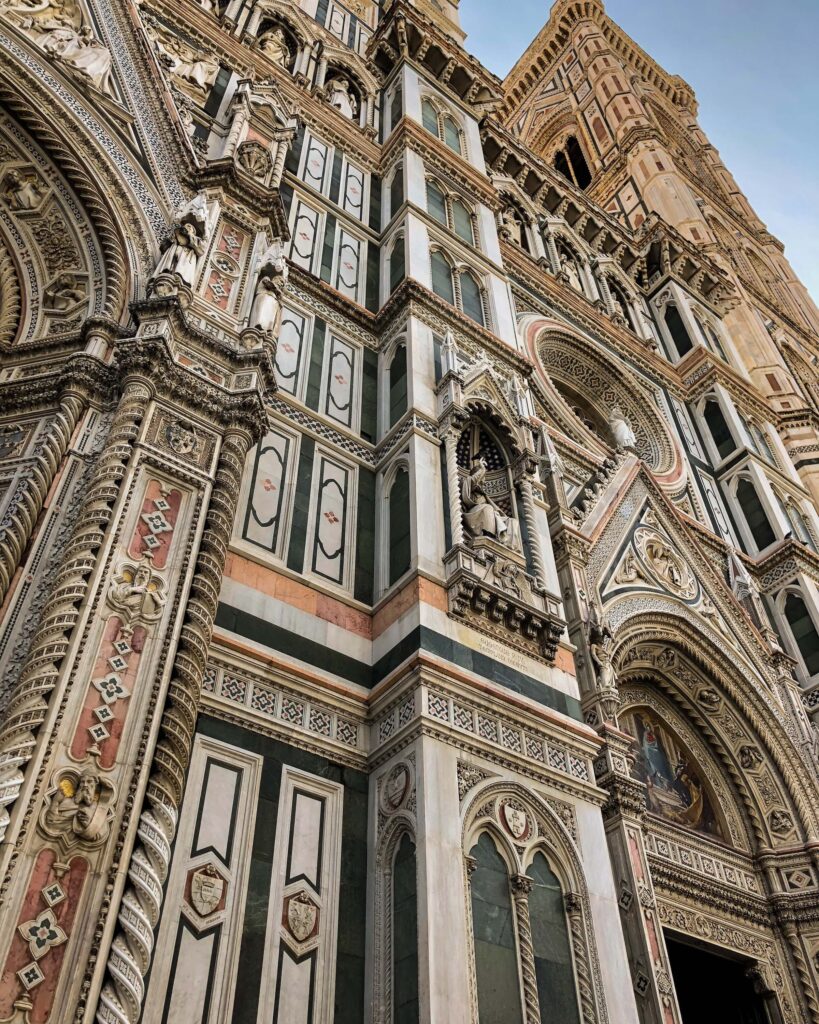
The original Florence cathedral facade, started by Arnolfo di Cambio at the end of the 13th century, was never finished. By the end of the 16th century it looked dated, and Grand Duke Francesco I dei Medici had it demolished.
A new facade was debated, but not built. So in the late 1600s Grand Duke Cosimo III had a large mural painted on the front of the church to look like a facade. This painted facade lasted for the next 150 years until the mid 1800s.
The 1850s saw a new Italian neo-Gothic facade built on nearby Santa Croce. This prompted renewed debate of what should be done with Santa Maria del Fiore.
In 1861 the Kingdom of Italy was unified, creating the country of Italy as we know it today. This unification led to Florence briefly being made the capital of Italy from 1865-1871. That meant a new facade was needed for the cathedral of the capital city.
This facade, in the Italian colors of red, white and green, was finally started by Emilio de Fabris in 1876. It was mostly completed by 1887. However it took a further 16 years (the same amount of time it took to build the entire dome!) to complete the bronze doors and finally create the cathedral we are familiar with today.
Michelangelo’s “David” was intended to decorate the Florence Cathedral roof
On the east end of the cathedral, along the roof line at the level of the duomo terraces, a series of 12 statues depicting Old Testament figures was planned. One of these, a terra cotta sculpture of Joshua, was completed by Donatello in 1410.
In 1464 a statue of David, to be carved from Carrara marble, was commissioned and awarded to Agostino di Duccio. He started the sculpture, but stopped working on it in 1466. In 1476 the marble was given to Antonio Rossellino to complete the commission.
However, his contract was terminated and the block of marble then sat unused for 26 years.
By 1501 Michelangelo, only 26 years old, had convinced the Opera del Duomo (the governing body of the cathedral) that he should be awarded the commission. Between 1501 and 1504 he carved his masterpiece, a six-ton colossus.
At this point the Opera del Duomo decided there was no way to hoist the massive statue to the roof. So a new location had to be found. It was decided that David should stand outside the Palazzo della Signoria. It’s the city’s town hall (now known as the Palazzo Vecchio, or Old Palace).
The David was installed in 1504, where it stood until 1873 when it was moved to the Accademia Gallery. A replica was put in its place in 1910.
Read more: The best things to do on your first trip to Florence
Brunelleschi is buried under the Florence Cathedral
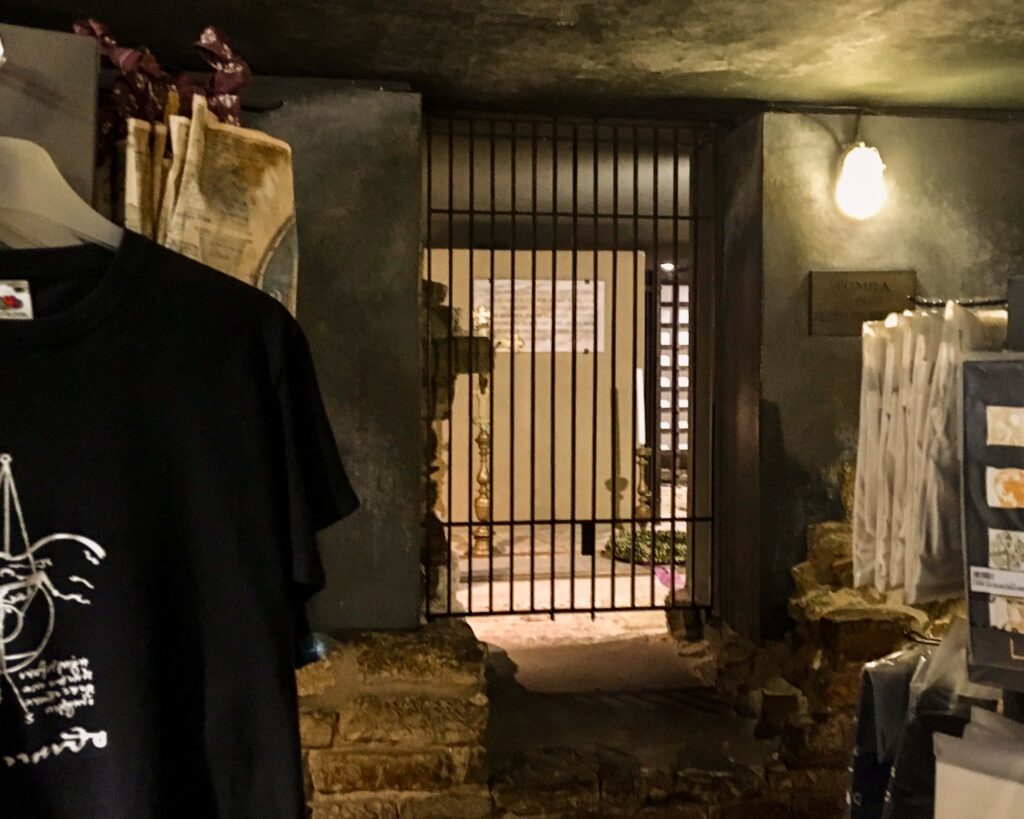
Unlike most churches and cathedrals, Santa Maria del Fiore has never been a burial place for the elite and influential.
Florence is a city filled with names of men who changed history. Names like Michelangelo, Lorenzo Ghiberti, Niccolò Machiavelli, and Galileo Galilei. Men who rocked and shaped the world as we know it today.
But none of them are buried in the Florence cathedral. Instead you can find their graves in nearby Santa Croce.
There are a few monuments, including a fresco funerary monument to Sir John Hawkwood painted by Paolo Ucello, and a fresco of Niccolò da Tolentino by Andrea del Castagno. But neither of these men are buried in the Florence cathedral either.
Only two men have been given the honor of being buried in the cathedral. One is Giotto, the architect who designed and built the Campanile (bell tower).
The other is Filippo Brunelleschi.
Just inside the southeast entrance of the cathedral is a dedication to Brunelleschi, which reads: “Both the magnificent dome of this famous church and many other devices invented by Filippo the architect, bear witness to his superb skill. Therefore, in tribute to his exceptional talents, a grateful country that will always remember buries him here in the soil below.”
And he is indeed buried below. In the crypt below the Florence cathedral, next to the gift shop, just past the rows of T-shirts and umbrellas shaped like the dome, is an unassuming locked iron gate. Most visitors never notice it.
Through this grate you’ll see a shrine bearing a simple latin inscription. Translated it reads “Here lies the body of the great ingenious man, Filippo Brunelleschi of Florence.”
The Florence Cathedral, Santa Maria del Fiore, also known as the Florence Duomo, is one of my favorite buildings in the world. It’s where I spent my college internship giving free tours to visitors. I spent hours explaining the art, architecture, and historic significance of the building.
The Florence Cathedral is also one of the most popular attractions in the city. The other most popular attractions are the Uffizi Gallery and the Palazzo Vecchio.



The cathedral’s dome dominates the city’s skyline. It’s a monument to Renaissance ingenuity and the crowning achievement of its architect, Filippo Brunelleschi.
It’s hard to imagine the skyline of Florence without Brunelleschi’s dome. It has a timeless feel, like it’s always been there.
Together with the Campanile di Giotto (Giotto’s campanile, or Giottos bell tower), the Florence Baptistry (Battistero di San Giovanni, or Baptistry of St. John), and Il Duomo, the buildings form the centerpieces of the Duomo complex, Piazza del Duomo, and the heart of the city of Florence.
But there are probably a few things you didn’t know about the Florence cathedral and dome.
Discover More: Florence Neighborhoods to Explore on Your Next Visit
When the Florence Duomo was started in 1296 no one knew how to build the dome

The Florence cathedral was built over the site of an older church, Santa Reparata. What is left of Santa Reparata can still be seen in the cathedral crypt.
The first stone for the new Florence Cathedral, Santa Maria del Fiore, was laid in September of 1296. It was intended to be a gothic church, with a design by Arnolfo di Cambio.
While the design was impressive, for years after the cathedral was started it remained roofless and open to the elements.
Why?
Because no one knew how to build a dome as big as the one planned for Santa Maria del Fiore.
The architects had designed a plan for a 45.5 meter (150 foot) wide dome to rise from the center of the magnificent building. However, the largest dome built to date was the Pantheon in Rome, measuring 43.4 meters (about 142 feet) and no one knew exactly how it had been constructed.
So what did the architects do?
They started building anyway, having faith that eventually someone would come along who knew how to build what they envisioned.
It took over 100 years after the cathedral was started, but they were right.
On August 19, 1418 a competition was declared, calling for anyone who could make a model or design for the dome itself or any piece of machinery that could help build it to submit their plans. The reward would be 200 gold Florins, more than a skilled craftsman could earn in two years of work.
Competitions like this were common during the Italian Renaissance of the 15th century, sort of a way to put work out for bid, and anyone could submit a model or idea for consideration.
One of the models was submitted by Filippo Brunelleschi, a 41 year old goldsmith and clockmaker. In the end it was his model that was accepted, and Brunelleschi began his life’s work of completing the dome.
It has the largest masonry dome in the world

To this day Brunelleschi’s dome is the largest masonry dome ever constructed.
It’s an ingenious structure, difficult to construct even with today’s advanced technologies. Engineers are still studying it and discovering the secrets of its construction.
In Brunelleschi’s day it would have been nearly impossible to build, and since he didn’t keep many records we still don’t know exactly how he did it.
What we do know is that failure was a definite option. Several domes and arches constructed prior to Santa Maria del Fiore failed. These included the Cathedral of Saint-Pierre at Beauvais in France which collapsed in 1284, only a decade after completion and less than 10 years before Santa Maria del Fiore was started.
Filippo Brunelleschi had no architectural training
A goldsmith by trade, Brunelleschi was ahead of his time in many ways. Not only did he design and oversee the construction of the cathedral dome, he also developed the science behind linear perspective and the vanishing point as we understand it in art today.
Brunelleschi had long been interested in solving mechanical problems, so at the age of 15 he was apprenticed to a goldsmith. Goldsmiths at that time were expected to possess varied talents, which made it a good fit for a boy of Brunelleschi’s mechanical bent.
He would have learned to set precious stones, cast metal, work with enamels, engrave silver, decorate with gold leaf, and other skills. Many well-known artists and sculptors previously trained as goldsmiths, including Leonardo da Vinci and Donatello.
Along with his training as a goldsmith, Brunelleschi also studied clock making, giving him extensive knowledge of weights, wheels and gears. This knowledge was key in building the dome, as he was required to build ingenious cranes and pulley systems to both lift and place the huge stone blocks and loads of bricks required during construction.
The dome wasn’t the only competition related to Il Duomo di Firenze that Brunelleschi entered.
In 1329, Andrea Pisano had crafted a beautiful set of doors for the east side of the Florence Baptistery (these doors now sit on the south side).
When it was time to create doors for the other sides of the Baptistry of St John, of course a competition was held. Brunelleschi entered this competition, along with Lorenzo Ghiberti and many other artists. Ultimately Ghiberti and Brunelleschi were both declared the winners and commissioned to work on the doors together, but this was a blow to Brunelleschi’s pride and he left for Rome.
Ghiberti went on to complete not only that set of doors, but also the most famous set known as the “Gates of Paradise”. These doors now stand in the Museo dellOpera del Duomo (Duomo Museum) to protect them from the elements, the doors on the baptistry are reproductions.
The Florence Cathedral dome was completed in only 16 years
Which is quite amazing considering the entire cathedral took over 140 years to build!
The competition for the building of the dome wasn’t held until 122 years after the first stone was laid in 1296. By the time Brunelleschi was born it had already been under construction for 80 years.
Given the radically new construction techniques, the machines that had to be designed and built just to lift the bricks and stones to the construction site, and the technical difficulties that had to be overcome, 16 years was an astoundingly short length of time to complete Brunelleschis dome.
There are 463 steps to the top

The dome of the Florence Cathedral wasn’t meant to be climbed by the public. The stairs were intended for construction and maintenance of the dome.
However, if you’re up to the climb it’s well worth the trek. It is the only way to see the interior frescos up close. You’ll also walk in the space between the inner and outer domes. Here you can see the ingenious construction methods for yourself.
You’ll see the frescoes, painted by Giorgio Vasari and Federico Zuccari, as you come out onto the walkways inside the cathedral just under the dome, close to the midpoint of the climb. If you’re afraid of heights this is not a climb for you! I didn’t realize I have, as my dad puts it, “a healthy respect for heights” until I climbed the dome for the first time a few years ago.
Stepping out onto the ledge inside the cathedral was… an experience.
Actually, it was quite terrifying. I almost had to turn around and go back, but decided I was determined to make it to the top.
Of course, the whole way up and down I was acutely aware of exactly what was below me. The interior dome, and a whole lot of nothing.
Would I do it again? Yes.
There’s no other way to see the detail of how the dome was built, and the view from the top is the most impressive in Florence. From up there you can see all the sights of Florence just by walking the circle of the lantern (the name for the structure on top of the dome).
If you make the climb, see if you can pick out the Pitti Palace, Boboli Gardens, and Piazzale Michelangelo across the Arno, the Palazzo Vecchio and Ponte Vecchio, and the churches of Santa Maria Novella, Santa Croce and San Lorenzo. On a clear day you can see up to Fiesole in the hills above the city.
Builders constructed the dome without using any centering
Builders use the term centering for wooden scaffolding or structures that support an arch or dome during construction. It was (and still is) a normal practice to build centering, then construct a dome.
But that would be a problem for the Florence Cathedral. It was so large and high off the floor that builders wouldn’t find enough trees in all of Tuscany to build centering.
There was discussion of using dirt instead, which had been done for other domes, but how would they excavate the space once the dome was built? One idea was to bury gold Florins in the dirt. When construction was complete, people could dig for the coins and excavate the building. This idea was quickly dismissed.
Every design submitted for the dome other than Brunelleschi’s required centering. But Brunelleschi’s design and model was radically different. When asked how he would complete the dome without support he wouldn’t say. He refused to give away technical details of his plans to ensure no one else could steal his ideas.
People branded Brunelleschi a madman, “an ass and a babbler.” Officials physically removed him from one meeting with the council while choosing the competition’s winner.
The council eventually adopted Brunelleschi’s design, but added one important condition. Builders would construct only the first 30 braccia (about 55 feet, or a quarter of the height) without centering. After that, the council would build it “according to what shall then be deemed advisable,” allowing for possible use of centering later.
In time, Brunelleschi proved his plans workable, and builders completed the rest of the Florence Cathedral dome without scaffolding or centering.
Only one side of the drum was completed
The drum is the octagonal section just below the dome that the dome rests on.
If you look at it from the outside you’ll notice something. One of the eight sides has a “balcony”, and seven sides are plain sandstone.
This drum decoration was designed by Baccio d’Agnolo. He started the project in 1506, but the design was criticized by Michelangelo as looking like a “cricket’s cage.”
At that point D’Agnolo stopped work on the drum and the work was never finished.
The facade of the Florence Cathedral wasn’t completed until 1903

The original Florence cathedral facade, started by Arnolfo di Cambio at the end of the 13th century, was never finished. By the end of the 16th century it looked dated, and Grand Duke Francesco I dei Medici had it demolished.
A new facade was debated, but not built. So in the late 1600s Grand Duke Cosimo III had a large mural painted on the front of the church to look like a facade. This painted facade lasted for the next 150 years until the mid 1800s.
The 1850s saw a new Italian neo-Gothic facade built on nearby Santa Croce. This prompted renewed debate of what should be done with Santa Maria del Fiore.
In 1861 the Kingdom of Italy was unified, creating the country of Italy as we know it today. This unification led to Florence briefly being made the capital of Italy from 1865-1871. That meant a new facade was needed for the cathedral of the capital city.
This facade, in the Italian colors of red, white and green, was finally started by Emilio de Fabris in 1876. It was mostly completed by 1887. However it took a further 16 years (the same amount of time it took to build the entire dome!) to complete the bronze doors and finally create the cathedral we are familiar with today.
Michelangelo’s “David” was intended to decorate the Florence Cathedral roof
On the east end of the cathedral, along the roof line at the level of the duomo terraces, a series of 12 statues depicting Old Testament figures was planned. One of these, a terra cotta sculpture of Joshua, was completed by Donatello in 1410.
In 1464 a statue of David, to be carved from Carrara marble, was commissioned and awarded to Agostino di Duccio. He started the sculpture, but stopped working on it in 1466. In 1476 the marble was given to Antonio Rossellino to complete the commission.
However, his contract was terminated and the block of marble then sat unused for 26 years.
By 1501 Michelangelo, only 26 years old, had convinced the Opera del Duomo (the governing body of the cathedral) that he should be awarded the commission. Between 1501 and 1504 he carved his masterpiece, a six-ton colossus.
At this point the Opera del Duomo decided there was no way to hoist the massive statue to the roof. So a new location had to be found. It was decided that David should stand outside the Palazzo della Signoria. It’s the city’s town hall (now known as the Palazzo Vecchio, or Old Palace).
The David was installed in 1504, where it stood until 1873 when it was moved to the Accademia Gallery. A replica was put in its place in 1910.
Read more: The best things to do on your first trip to Florence
Brunelleschi is buried under the Florence Cathedral

Unlike most churches and cathedrals, Santa Maria del Fiore has never been a burial place for the elite and influential.
Florence is a city filled with names of men who changed history. Names like Michelangelo, Lorenzo Ghiberti, Niccolò Machiavelli, and Galileo Galilei. Men who rocked and shaped the world as we know it today.
But none of them are buried in the Florence cathedral. Instead you can find their graves in nearby Santa Croce.
There are a few monuments, including a fresco funerary monument to Sir John Hawkwood painted by Paolo Ucello, and a fresco of Niccolò da Tolentino by Andrea del Castagno. But neither of these men are buried in the Florence cathedral either.
Only two men have been given the honor of being buried in the cathedral. One is Giotto, the architect who designed and built the Campanile (bell tower).
The other is Filippo Brunelleschi.
Just inside the southeast entrance of the cathedral is a dedication to Brunelleschi, which reads: “Both the magnificent dome of this famous church and many other devices invented by Filippo the architect, bear witness to his superb skill. Therefore, in tribute to his exceptional talents, a grateful country that will always remember buries him here in the soil below.”
And he is indeed buried below. In the crypt below the Florence cathedral, next to the gift shop, just past the rows of T-shirts and umbrellas shaped like the dome, is an unassuming locked iron gate. Most visitors never notice it.
Through this grate you’ll see a shrine bearing a simple latin inscription. Translated it reads “Here lies the body of the great ingenious man, Filippo Brunelleschi of Florence.”